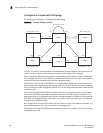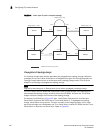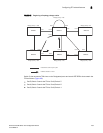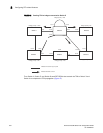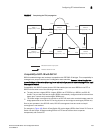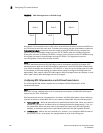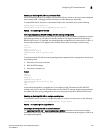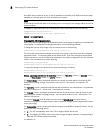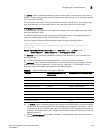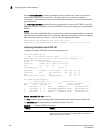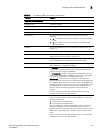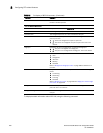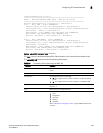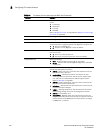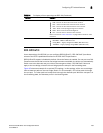
258 PowerConnect B-Series FCX Configuration Guide
53-1002266-01
Configuring STP related features
8
Once 802.1W is enabled on a port, it can be disabled on individual ports. 802.1W that have been
disabled on individual ports can then be enabled as required.
NOTE
If you change the 802.1W state of the primary port in a trunk group, the change affects all ports in
that trunk group.
To disable or enable 802.1W on an individual port, enter commands such as the following.
PowerConnect(config)#interface e 1
PowerConnect(config-if-e1000-1)#no spanning-tree
Syntax: [no] spanning-tree
Changing 802.1W bridge parameters
When you make changes to 802.1W bridge parameters, the changes are applied to individual ports
on the bridge. To change 802.1W bridge parameters, use the following methods.
To designate a priority for a bridge, enter a command such as the following.
PowerConnect(config)#spanning-tree 802-1w priority 10
The command in this example changes the priority on a device on which you have not configured
port-based VLANs. The change applies to the default VLAN. If you have configured a port-based
VLAN on the device, you can configure the parameters only at the configuration level for individual
VLANs. Enter commands such as the following.
PowerConnect(config)#vlan 20
PowerConnect(config-vlan-20)#spanning-tree 802-1w priority 0
To make this change in the default VLAN, enter the following commands.
PowerConnect(config)#vlan 1
PowerConnect(config-vlan-1)#spanning-tree 802-1w priority 0
Syntax: spanning-tree 802-1w [forward-delay <value>] | [hello-time <value>] | [max-age <time>]
| [force-version <value>] | [priority <value>]
The forward-delay <value> parameter specifies how long a port waits before it forwards an RST
BPDU after a topology change. This can be a value from 4 – 30 seconds. The default is 15
seconds.
The hello-time <value> parameter specifies the interval between two hello packets. This parameter
can have a value from 1 – 10 seconds. The default is 2 seconds.
The max-age <value> parameter specifies the amount of time the device waits to receive a hello
packet before it initiates a topology change. You can specify a value from 6 – 40 seconds. The
default is 20 seconds.
The value of max-age must be greater than the value of forward-delay to ensure that the
downstream bridges do not age out faster than the upstream bridges (those bridges that are closer
to the root bridge).
The force-version <value> parameter forces the bridge to send BPDUs in a specific format. You can
specify one of the following values:
• 0 – The STP compatibility mode. Only STP (or legacy) BPDUs will be sent.
• 2 – The default. RST BPDUs will be sent unless a legacy bridge is detected. If a legacy bridge is
detected, STP BPDUs will be sent instead.
The default is 2.



